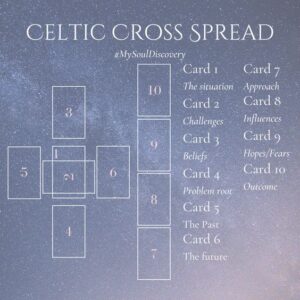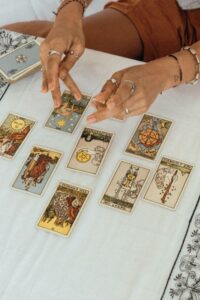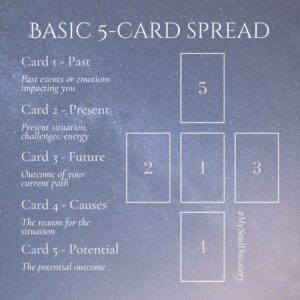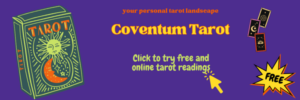Embarking on the journey of tarot reading unveils a mystical path of self-discovery and insight. This guide aims to demystify the process for novices eager to learn tarot card reading and master the foundational tarot spreads. If you want to learn more about tarot’s history and purpose, check out this article.
Setting the Stage for Your Tarot Reading
Before diving into the cards, setting the right environment enhances the experience. Begin by finding a quiet, comfortable space where disturbances fade into the background. Lay out your tarot cloth and seat yourself facing east if possible, as it symbolizes new beginnings. Start with a simple ritual to connect with your deck. Shuffle the cards while focusing on your intention for the reading. This initial bonding paves the way for clear and insightful readings.
Cleansing Your Tarot Deck

Cleansing your tarot cards is crucial for removing any lingering energies and ensuring a fresh start for each reading. Popular methods include passing the deck over burning sage or placing a clear quartz crystal atop the deck for a few hours. A quick shuffle before each reading also helps to reset the deck’s energy.
Opening and Closing a Tarot Reading
Opening your reading begins with a question or a topic in mind. Shuffle the cards while concentrating on the question, then draw the cards with your right hand. Place them according to your chosen spread. After interpreting the cards, close your reading by thanking the deck for its guidance. Reshuffle the cards, and store them safely away, ready for the next session.

Understanding Tarot Basics
Tarot decks consist of 78 cards divided into the Major and Minor Arcana. The Major Arcana represents major life changes and karmic lessons. The Minor Arcana delves into the day-to-day aspects of life. Interpreting the cards involves not just understanding the symbolic meanings but also trusting one’s intuition to weave the story the cards are telling.
Popular and Basic Tarot Spreads
These popular and basic spreads, designed to guide beginners through their first steps in tarot reading, also provide valuable insights for more seasoned practitioners. You can interpret cards in many different ways, according to your question.
Exploring 3 Card Tarot Spreads
Three card tarot spreads offer a straightforward entry into the art of tarot readings, providing clear and concise insights. Beginners find this layout particularly useful as it requires less interpretation while still covering various aspects of a query.
There are several types of three-card spreads, each tailored to different areas of inquiry:
- 3 Card Tarot Spread – Past, Present, Future: This spread is ideal for beginners and provides quick insights. Draw three cards: the first represents past influences, the second shows the current situation, and the third reveals potential future outcomes.
- 3 Card Career Tarot Spread: Focus on your career path with this spread. The first card reflects current work-related situations, the second indicates actions needed for advancement, and the third reveals upcoming opportunities or challenges.
- 3 Card Relationship Tarot Spread: Use this spread to explore relationship dynamics. Each card can reflect your role in the relationship, the other person’s position, and the interaction between the two.

5 Card Tarot Spreads
The 5 card tarot spread is a versatile technique that offers a more nuanced exploration of a situation than the 3 card spread. Yet it remains less complex than the Celtic Cross. So, ideal for intermediate learners. This spread allows for a broader view of circumstances by examining different aspects through five distinct positions.
5 Card Tarot Meaning
Here’s a breakdown of what each card typically represents:
- First Card: The Present – This card represents the current situation or the immediate context in which the question is being asked. It reflects the querent’s current feelings, thoughts, or circumstances.
- Second Card: The Past – This card shows influences, events, or emotional states from the querent’s past that are impacting the current situation. It can provide insight into how past dynamics are shaping present decisions.
- Third Card: The Future – This card indicates possible outcomes and directions that may occur based on the current trajectory. It’s a projection of where things are heading if the current path continues.
- Fourth Card: The Reason – This card sheds light on the underlying reasons for the question or situation. It often reveals hidden factors, motivations, or truths that are influencing the matter at hand.
- Fifth Card: The Potential – This card highlights the potential within the situation for learning, growth, or resolution. It suggests what could be achieved or realized, depending on the choices made by the querent.
This layout not only helps in decision-making by providing a sequence of steps and their outcomes but also deepens the reader’s understanding of how various factors interact within the context of the query. This spread is particularly useful for answering specific questions where multiple factors need to be considered, offering a comprehensive snapshot of past, present, and potential future influences.
Understanding the Celtic Cross Spread
The Celtic Cross is one of the most comprehensive and widely used tarot spreads due to its depth and complexity. It is ideal for gaining detailed insights into complicated situations. The spread consists of ten cards, each occupying a specific position that represents different facets of the question at hand.
Celtic Corss Cards Meaning
Here’s a detailed breakdown of the meaning of each card in the Celtic Cross tarot spread:
- The Present – This card represents what is currently happening to the querent, capturing the essence of the moment and the main issue or situation at hand.
- The Challenge – Positioned across the first card, this card indicates the immediate challenge or obstacle facing the querent, which may either hinder or compel the situation forward.
- The Past – This card reflects the events that have led up to the current situation. It highlights the foundational influences and past experiences that still impact the querent’s life.
- The Future – This card shows the potential future; it represents what is likely to occur within the next few weeks or months, based on the trajectory set by past and present circumstances.

5. Above (Conscious) – This card symbolizes the querent’s goals or aspirations, what they are consciously working towards, and their understanding of the situation.
6. Below (Subconscious) – This card reveals the underlying feelings, hidden forces, and subconscious influences that affect the current path or circumstances.
7. Advice – Positioned in the column of four cards to the right of the cross, this is the first card that suggests the approach or attitude needed, offering guidance on how to handle the situation depicted by the spread.
8. External Influences – This card indicates the people, energies, or events in the querent’s environment that might affect the outcome of the situation, highlighting external forces they may need to consider or confront.
9. Hopes and Fears – This card often reflects the querent’s psychological aspect, capturing their hopes and fears related to the situation, which can either motivate or block progress.
10. Outcome – The final card in the spread provides insight into where the situation is headed and the likely final outcome, based on the current energies and paths unfolding.
This spread provides a thorough analysis, making it a favorite for addressing complex and significant life questions. Each position in the Celtic Cross offers a layer of understanding that, when pieced together, provides a detailed and nuanced view of the querent’s situation.



